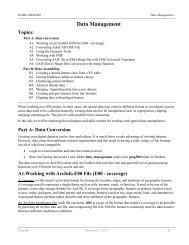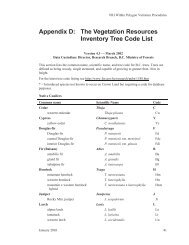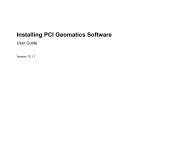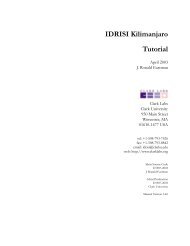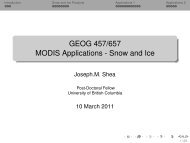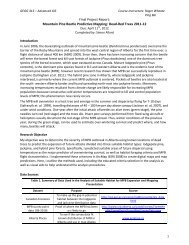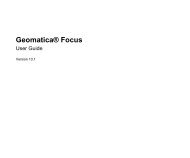Understanding Map Projections
Understanding Map Projections
Understanding Map Projections
You also want an ePaper? Increase the reach of your titles
YUMPU automatically turns print PDFs into web optimized ePapers that Google loves.
BIPOLAR OBLIQUE CONFORMAL CONIC<br />
DESCRIPTION<br />
This projection was developed specifically for<br />
mapping North and South America. It maintains<br />
conformality. It is based on the Lambert Conformal<br />
Conic, using two oblique conic projections side by<br />
side.<br />
PROJECTION METHOD<br />
Two oblique conics are joined with the poles<br />
104 degrees apart. A great circle arc 104 degrees<br />
long begins at 20° S and 110° W, cuts through<br />
Central America, and terminates at 45° N and<br />
approximately 19°59'36" W. The scale of the map is<br />
then increased by approximately 3.5 percent. The<br />
origin of the coordinates is 17°15' N, 73°02' W<br />
(Snyder, 1993).<br />
display North America and South America only. If<br />
having problems, check all feature types (particularly<br />
annotation and tics) and remove any features that<br />
are beyond the range of the projection.<br />
USES AND APPLICATIONS<br />
Developed in 1941 by the American Geographical<br />
Society as a low-error single map of North and South<br />
America.<br />
Conformal mapping of North and South America as a<br />
contiguous unit.<br />
Used by USGS for geologic mapping of North<br />
America until it was replaced in 1979 by the<br />
Transverse Mercator projection.<br />
LINES OF CONTACT<br />
The two oblique cones are each conceptually secant.<br />
These standard lines do not follow any single<br />
parallel or meridian.<br />
LINEAR GRATICULES<br />
Only from each transformed pole to the nearest<br />
actual pole.<br />
PROPERTIES<br />
Shape<br />
Conformality is maintained except for a slight<br />
discrepancy at the juncture of the two conic<br />
projections.<br />
Area<br />
Minimal distortion near the standard lines, increasing<br />
with distance.<br />
Direction<br />
Local directions are accurate because of<br />
conformality.<br />
Distance<br />
True along standard lines.<br />
LIMITATIONS<br />
Specialized for displaying North and South America<br />
only together. The Bipolar Oblique projection will<br />
40 • <strong>Understanding</strong> <strong>Map</strong> <strong>Projections</strong>




